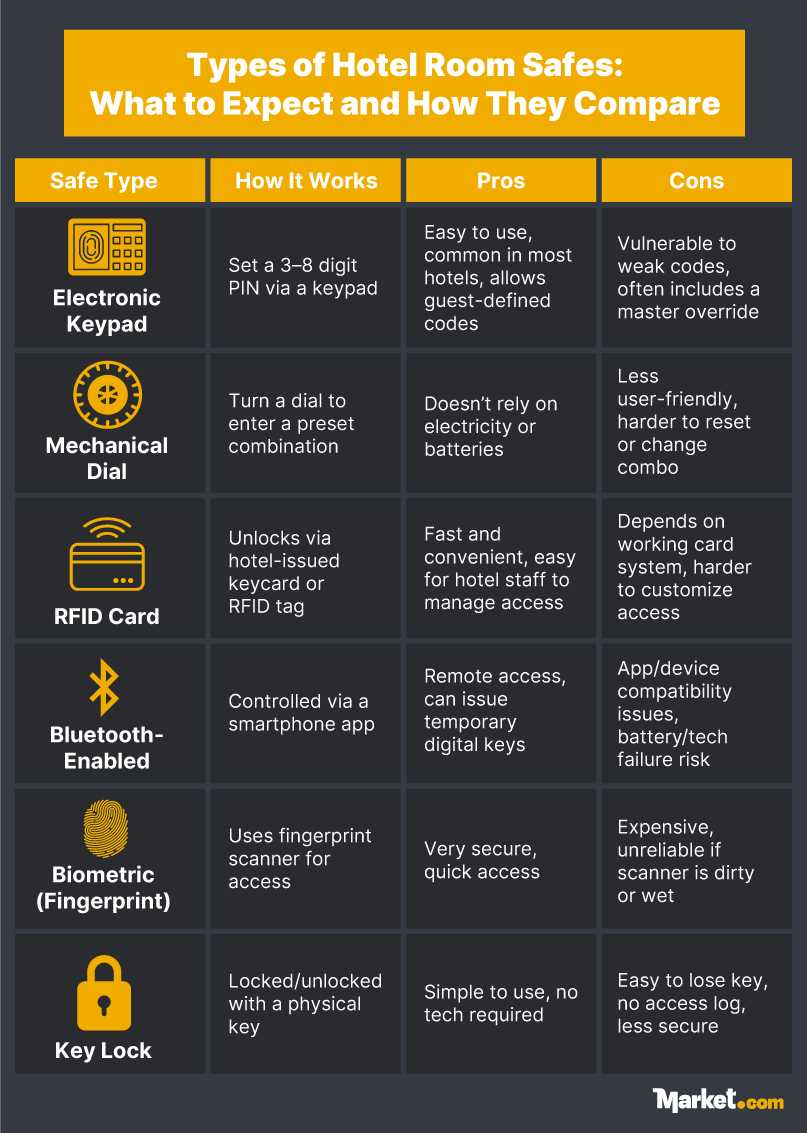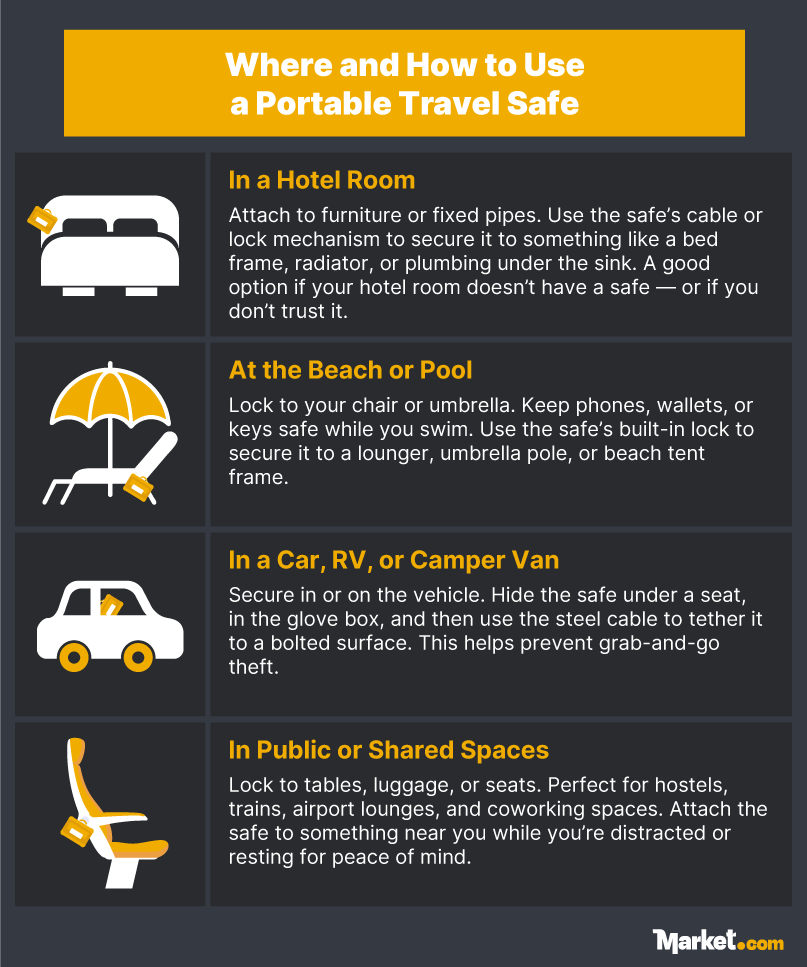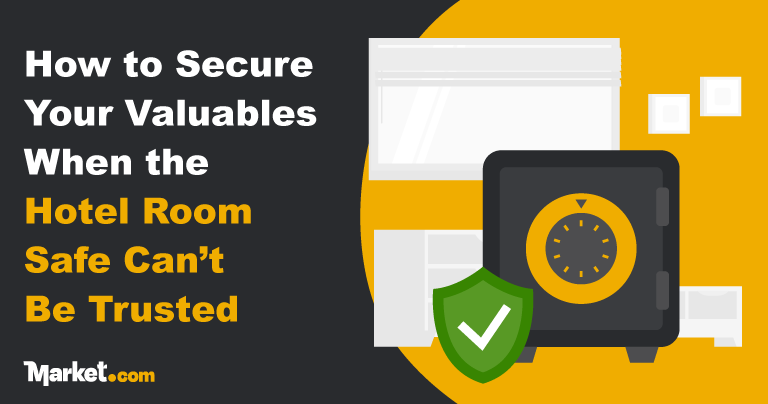Most travelers don’t think twice about using hotel room safes. Password-protected and out of sight, they’re assumed to be the best place to secure your belongings while you’re on a trip.
Unfortunately, that sense of security is often misplaced. Most are accessible to staff who have access keys and codes. Many older models rely on outdated security technology that’s easily defeated by a knowledgeable thief. And some hotels fail to properly secure their in-room safes, allowing bad actors to simply take the safe — and everything in it!
This guide takes a closer look at how hotel safes work, what risks you should be aware of when you use them, and which types are the most secure. We’ll also share practical ways to secure your belongings while traveling, like portable travel safes.
The Most Common Types of Hotel Room Safes
Hotel safes vary in how they operate, where they’re placed, and what they’re designed to store. Most modern hotels have electronic multi-user safes, built to be reused by different guests. These include override features, like a master code or manual key, that allow hotel staff to unlock the safe if it’s left locked at checkout.

The most common types of hotel safes you’ll come across are:
- Electronic keypad safes: The standard in most hotels. Guests set a PIN (usually 3–8 digits) to secure the safe. Override methods are typically built in for staff.
- Mechanical code safes: Use a rotating dial to enter a combination. Mostly found in older or budget accommodations.
- RFID card safes: Unlock with a proximity card, similar to room keycards. Convenient, but depend on pre-programmed access credentials.
- Bluetooth-enabled safes: Controlled via a smartphone app. These may support features like remote unlocking or temporary codes. Usually seen in newer hotels.
- Biometric safes: Use fingerprint recognition. Uncommon, but sometimes available in premium hotels.
- Key lock safes: Opened with a physical key. Largely phased out in newer hotels due to limited access tracking.
Safes come in a range of formats depending on room layout. You’ll usually find hotel safes installed in a closet, drawer, or mounted inside furniture.
Most are front-opening, with a door that swings outward. Others are top-opening, with a lid that opens upwards, or sliding-door style, which work like drawers and are practical for smaller rooms.
Sizes also vary. Compact safes hold passports, cash, and small electronics, while larger models are built to fit laptops or folders. Some hotels offer oversized safes in suites for added storage.
The Vulnerabilities of Hotel Room Safes
Hotel safes are designed for convenience, not high security. They deter casual theft, but many rely on outdated technology, weak override systems, and inconsistent maintenance. This leaves them vulnerable to tampering, even when guests follow all the recommended precautions.
In some cases, thieves don’t need to be especially skilled to gain access. A 2023 incident at the Paris Hotel in Las Vegas saw guests reporting missing valuables from inside locked safes. One guest even discovered a beer can left behind in the safe. The suspect was later arrested, and while details weren’t made public, reports suggested possible inside help.
Other attacks are more organized. In Europe, a gang that specialized in hotel safe burglaries robbed at least 16 hotels across multiple countries. The group posed as guests, used stolen keycards to enter rooms, and drilled directly into safes, stealing over €50,000 in the process.
And for opportunistic thieves, there’s no shortage of tutorials. A quick search on platforms like TikTok or YouTube returns thousands of videos showing how to bypass hotel safes, some with millions of views. Many rely on default codes or quick override hacks that still work on older models.
Why have hotel room safes become such a target for thieves? The following sections explore some of the key reasons.
Temporary PINs and Override Risks
Many hotel safes require guests to program a new PIN each time they use them. The process typically involves entering a code and then confirming with a particular button. This PIN is only valid until the safe is opened again.
If this step isn’t done correctly, the safe may not lock at all, leaving your valuables unsecured without you necessarily realizing it. Safes don’t always provide clear feedback, so it’s easy to assume they’re locked when they’re not.
There’s also a risk if override codes aren’t regularly updated. While intended for emergency access, many safes still use factory-set codes that can be found online. In these cases, someone with the default code could open the safe without any visible signs of entry.
Cheap Materials and Sloppy Installation
Some hotel safes are small, lightweight, and often not bolted down — making them easy to remove entirely.
A thief who gains access to your room could simply walk off with the safe and attempt to open it later. While loud tools like drills or grinders are rarely used during hotel thefts, they can be effective once the safe is off-site.
Poor construction is also common. Safes made with thin steel or low-quality locking mechanisms can often be bypassed with basic tools or simple lock-picking methods. With a bit of know-how, some safes can be cracked in between two to ten minutes; even faster if factory-set codes or reset buttons are left unchanged.
Attractive Targets
Hotel room safes are often standardized, meaning hundreds of rooms in the same property might use the exact same model, with the same vulnerabilities. If someone figures out how to bypass one, they may be able to bypass them all.
This, combined with easy room access, can make safes an appealing target for opportunistic theft. While hotel theft is often assumed to be the work of outside intruders, some experts say that many incidents are inside jobs. According to lodging security director Michael Moske, 60–70% of hotel thefts are committed by staff members.
That doesn’t mean theft is widespread among employees. Low wages, understaffing, and weak internal controls can create environments where crimes of opportunity are more likely to occur.
Securing Your Belongings When You Travel
Hotel safes offer a basic level of protection, but they’re not your only option. If you’re carrying valuables like passports, electronics, or cash, it’s worth considering some secure storage alternatives for your trip.
Choose What to Keep With You and What to Store
Deciding what to lock up and what to carry is a balancing act between practicality and risk. Evaluate which of your items are necessary for daily use and which can be stored while you’re out and about.
You’ll want to keep your passport, ID, primary credit card, daily cash allowance, as well as personal electronics like your phone and smartwatch with you. A money belt or sling bag and portable travel safe are great options for keeping these items safe while you’re out and about.
It’s also good practice to photograph your important items and documents and back them up to the cloud. This makes it easier to report losses or file insurance claims if needed.
Larger items, like laptops, tablets, and other electronics, are better left at the hotel. The same goes for backup cards, cash, foreign currency, as well as jewelry and other valuables. You can also store physical copies of less sensitive documents in your in-room safe. Just be sure to have a digital copy at hand, too.
Secure Your Things Elsewhere in the Hotel
In situations where in-room safes aren’t available, or when you simply don’t trust them, there are a few alternatives that you can opt for.
Using Hotel Reception Safes
Some hotels offer secure storage at the front desk. These are typically more secure than in-room safes, particularly in hotels that limit access to a small number of senior staff. There’s also a higher chance that the reception area is monitored by surveillance cameras.
Keep in mind that reception safes are still not immune to internal theft and may not be available in all accommodations.
Locking Your Luggage
Securing your suitcase with a TSA-approved combination lock can help deter casual theft, especially in rooms without a safe. While not high security, it adds a barrier that can discourage crimes of opportunity.
Hiding Your Things
Some travelers choose to conceal their valuables in less obvious places — think under mattresses, inside clothing or laundry, or tucked into the pages of a Bible. While these methods won’t stop a thorough search, they may reduce the risk of opportunistic theft.
Attaching a Safe Lock to Your In-room Safe
You can buy a safe lock and physically attach it to the door of a hotel room safe. This prevents it from being opened, even if someone has an override code or master key. Although some models come with basic padlocks, you might need to upgrade to a more durable lock for better security.
Get a Portable Travel Safe
A portable travel safe offers a way to secure your valuables while you’re on the go, whether you’re staying in a hotel, hostel, vacation rental, or another type of shared accommodation. They can often be attached to fixed objects, like furniture or pipes, reducing the risk of theft.

These safes can be especially useful in situations where secure storage is limited or unreliable. They can be especially practical for:
- Backpackers and solo travelers, or those staying in hostels or budget hotels (where shared access and limited security are common).
- Digital nomads and remote workers who often carry more tech than the average traveler.
- Travelers in high-theft areas or on extended trips through regions where petty theft is a known concern.
- RV and van travelers, who may spend nights in unsecured areas without the benefit of hotel infrastructure
- Urban commuters and city travelers carrying valuables in public spaces — especially where phone theft is a common concern.
Choosing a Portable Travel Safe
Portable travel safes give you control over where and how your valuables are stored, whether carried along for the day or locked to a fixed object inside a hotel room. This added flexibility makes them especially useful in shared or unpredictable environments.
Types of Portable Travel Safes
While there are a lot of different types of portable travel safes, there’s not really a universal model that works for everyone. The best portable safe for you depends on what you’re securing, how you’re traveling, and where you plan to use it.
Lockbox-Style Safes
Compact and hard-sided, these models typically include combination locks and are suitable for storing small items like passports, mobile devices, or cash. They fit easily inside luggage or hotel room drawers.
Cable-Lock Bags
Constructed from slash-resistant fabric or reinforced mesh, these safes are sealed with a locking cable that can be looped around a fixed object. They offer more flexibility in shape and capacity compared to traditional lockboxes.
Biometric Safes
Some portable safes use fingerprint scanners or facial recognition to restrict access. These models may offer stronger access control but can be less practical for travel due to size, cost, and power requirements.
Steel Mesh Enclosures
This model allows you to secure your entire bag or backpack inside a lockable mesh shell. Commonly used in hostels or outdoor settings, they protect against grab-and-go theft in shared environments.
Water-Resistant or Weather-Proof Safes
Designed for outdoor use, these safes typically include moisture seals and rugged exteriors. They intended to protect your belongings in wet conditions, such as near water or in regions with variable weather.
Portable Travel Safe Sizes
Besides differing in material and access method, portable travel safes also vary in size. What you need to secure and how mobile you need it to be will determine the size of the portable travel safe you choose.
Keep in mind that some portable safes can weigh up to 3 lbs (1.4 kg), even when empty. If you’re traveling light or limited to carry-on luggage, this may not be the most practical option. In those cases, you may want to consider some of the alternatives to in-room safes mentioned earlier.
Other Hotel Room Safety Tips
Even with secure storage, overall hotel room safety plays a big role in protecting your belongings. A few simple habits can help reduce your exposure to theft:
- Use the “Do Not Disturb” sign when you’re out. This discourages unnecessary entry and creates the impression that someone is inside the room.
- Double-lock doors and windows, especially the balcony or ground-level access points. Many thefts happen through unlocked access points rather than forced entry.
- Keep valuables out of sight, even when in use. Avoid leaving phones or wallets near open windows or in the eyeline from the hallway.
- Label important items subtly but distinctly. Some travelers add initials or contact info inside laptops or luggage (never on the outside) to aid in recovery.
These precautions don’t take much time or effort, but they can help secure your belongings and give you extra peace of mind.
The Bottom Line
Hotel safes might seem like a safe bet, but they’re far from foolproof. Between outdated models, shared override access, and a lack of oversight, they often offer less protection than travelers expect.
That doesn’t mean you’re out of options, it just means taking a more proactive approach. Whether it’s bringing a portable travel safe, locking your luggage, or simply being more selective about what you leave behind, small precautions can make a big difference.
Your belongings deserve more than blind trust in a metal box. With a little planning, you can keep them secure and travel with fewer risks (and fewer regrets).



